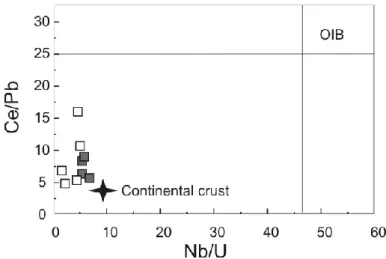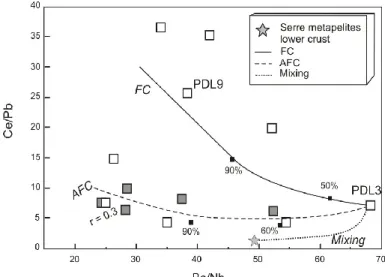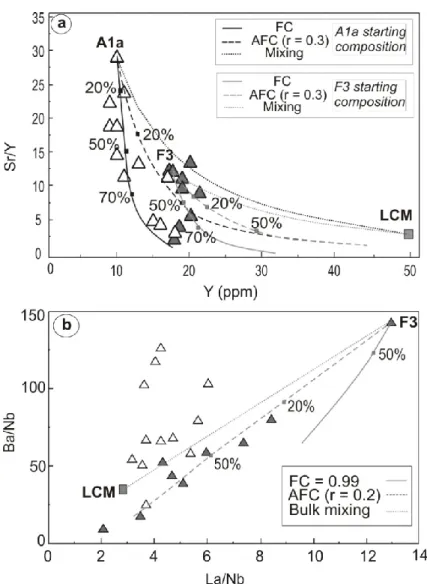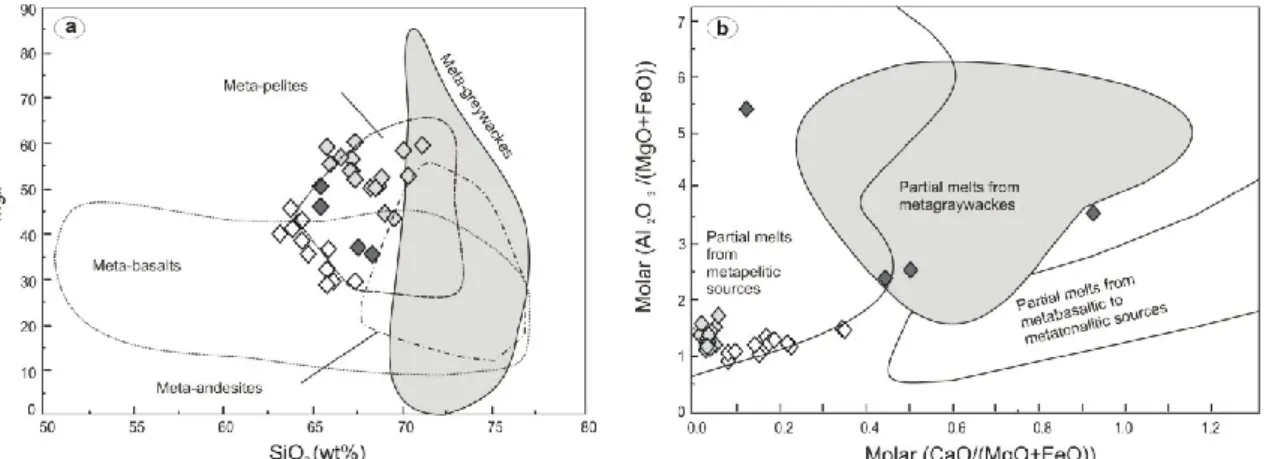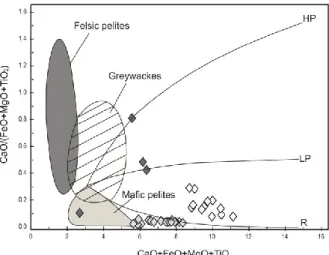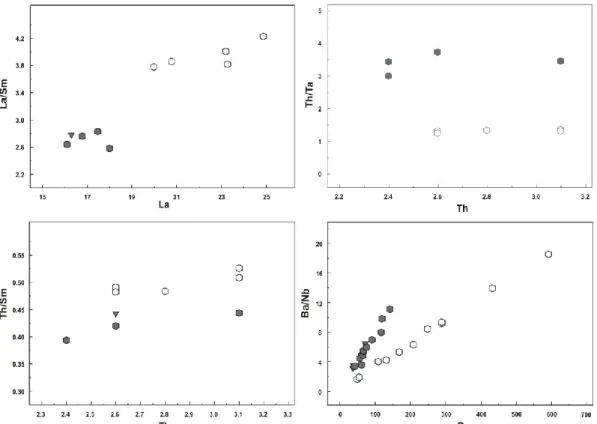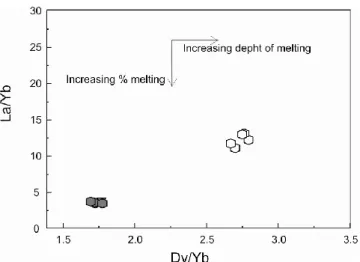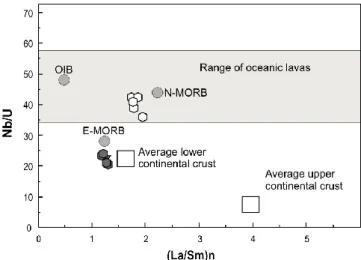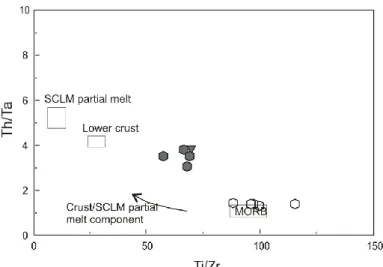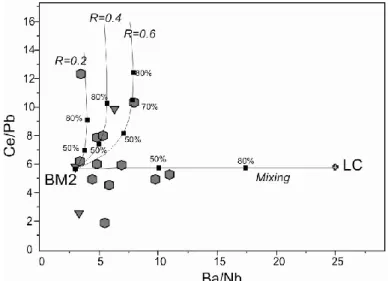101
Chapter 7 –
PETROGENETIC MODELS
7.1 Calabrian dykes
Geochemical features of the less evolved Serre dykes suggest an origin from mantle sources modified by fluids produced by metamorphic dehydration reactions during subduction of oceanic slabs. The absence of iron enrichment in the first evolutionary stages is probably the strongest evidence for their calcalkaline character (e.g., Arculus, 2003). This, coupled with low TiO2 and relatively low alkali contents resemble closely the chemical composition of magmas emplaced along active or fossil subduction zones (e.g., Lustrino et al., 2011, and references therein). Unlike typical arc-type rocks, the Serre dykes display a distinct Ba negative anomaly with respect to the adjacent Rb and Th. This trough can be considered not related to the alteration processes but a consequence of crystal fractionation or of distinctive source characteristics. This feature also occurs in Plio-Quaternary potassic to ultrapotassic subduction-related rocks from peninsular Italy (Peccerillo and Martinotti, 2006; Avanzinelli et al., 2009; Conticelli et al., 2010, and references therein). Among the incompatible trace elements, the HFSE troughs, the positive Pb anomaly and the high LILE/HFSE ratios are classically considered as typical features of subduction-related igneous rocks (Gill, 1981; Grove and Kinzler, 1986; Tatsumi, 1989; Davies and Stevenson, 1992; Hawkesworth et al., 1993; Arculus, 1994; Pearce and Peate, 1995). These characteristics have been commonly explained by the addition of hydrous fluids released from subducting oceanic lithosphere, selectively enriched in LILE and in other fluid-mobile elements (e.g., Pb, U, with high to very high Pb/U ratios), to the mantle wedge, lowering the mantle solidus and leading to magma generation.
The occurrence of such subduction-related geochemical characteristics is at odd with the envisaged tectonic setting of the emplacement of the dykes, having been these emplaced after the end of the Gondwana-Laurasia collision (e.g., Stampfli and Borel, 2002). In fact, a general agreement exists that late-Hercynian Calabrian magmas were emplaced in an extensional tectonic setting associated with the post-collisional
102
attenuation of the previously thickened lithosphere in consequence to possible slab detachment (Caggianelli et al., 2007; Angì et al., 2010,).
The Sr - Nd isotopic composition of the Serre dykes (87Sr/86Sri = 0.7098 - 0.7254; εNdi = from – 4.10 to – 8.49) is also consistent with the hypothesis of melts
deriving form an enriched mantle source, metasomatized by subduction-related components. Additionally, it suggests the interaction of produced melts, via AFC or mixing processes, with silicic crustal rocks likely akin tothe metasedimentary rocks of the Serre lower crust (Caggianelli et al. 1991) that, seem also to represent the main source of the most acidic Serre dykes.
In the next paragraphs, the possible petrogenetic models that may better explain the calcalkaline dyke magmatism in the Serre Massif will be investigated.
7.1.1 Serre basaltic andesites
Serre basaltic andesites include two distinct sample groups, LMA and PDL, both intruding upper crustal paragneisses in the Mammola area.
PDL group rocks were affected by a prominent spilite-type hydrothermal alteration modifying the primary mineralogical assemblage. On the contrary, LMA basaltic andesites suffered a less extensive alteration process allowing the primary magmatic microstructures and mineralogical assemblages to be still preserved.
However, the different alteration conditions are not clearly reflected in the major and trace elements geochemical features, that in many cases show similar correlation trends or scattered distributions.
The same occurs for the normalized REE and incompatible elements patterns that are uniformly enriched in LILE, depleted in HFSE and showing Ta-Nb and Ti troughs and a slight positive Pb anomaly, except for one sample that usually deviates from these common geochemical behaviors.
As a whole group, basaltic andesites are characterized by Mg# values ranging from 58 to 71, suggesting variable degrees of crystal fractionation, and high MgO (7.66 - 13.21 wt.%), Ni (48 - 127 ppm) and Cr (151 - 365 ppm) contents that could reflect a mantle origin.
Possible mantle sources can be represented by the asthenosphere metasomatized by subduction-related fluids/melts or by the metasomatized continental lithospheric mantle.
103
Besides, calcalkaline compositions could also result from the interaction between mantle-derived melts with local crust.
Studied basaltic andesites show geochemical features suggestive of these interaction, such as the low La/Nb ratios (nearly constant values averaging at 3.3 in the LMA samples and much more variable values of 1.2-8.1 in the PDL group) and the widely variable Ba/Nb ratios ranging from 24.5 to 52.4 and from 19.3 to 68.4, in LMA and PDL samples, respectively. In addition, the Ce/Pb ratio can also indicate crustal contamination for samples with values approximating that of the continental crust (= 3.9; Shimizu and Arculus, 1975; Pearce, 1983; Rudnick and Fountain, 1995; Rudnick and Gao, 2003; Fig. 7.1).
Fig. 7.1: Ce/Pb vs. Nb/U. OIB field and continental crust average composition from McDonald et al.
(2001) and Wilson et al. (1989), respectively.
Nevertheless, these trace elements ratios, coupled with the Pb peak and Ta-Nb negative anomaly in the primitive mantle normalized patterns and the Sr-Nd isotopic composition, might be caused by either magma mixing, crustal contamination as well as concurrent assimilation and fractional crystallization (AFC; De Paolo, 1981).
What now must be established is to understand if the interaction with crustal rocks (typically characterized by low HFSE, high LILE, high LILE/HFSE and high Pb; e.g., Rudnick and Gao, 2003, and references therein) did happen at mantle depths, at the magma-source (e.g., after recycling of crustal rocks along subduction zones) or at
104
crustal depths, during interaction of mantle melts with crustal lithologies (e.g., in magma chambers, via AFC processes).
To test the crustal contribution in basaltic andesites evolution, FC-AFC and mixing calculations have been carried out by using the FC–AFC–FCA and mixing modeller program of Ersoy and Helvaci (2010), on the Ce/Pb and Ba/Nb ratios (Fig. 7.2).
Calculations have been performed starting from sample PDL3, chosen as starting composition (SiO2 = 51.12 wt. %, MgO = 9.19 wt. %, Ni = 97 ppm, Cr = 347 ppm), and selecting the metapelitic Serre lower crust (Del Moro et al., 2000) as contaminant. Results show that all LMA basaltic andesites and only some of the PDL group, are intercepted by an AFC model line (r = assimilation/fractionation ratio = 0.3) reflecting assimilation of about 20 – 30 % of crustal rocks.
On the other hand, the composition of numerous PDL samples can be hardly explained by AFC or FC processes, likely for the prominent spilitization affecting these samples. Nevertheless, a model of simple fractional crystallization, implying fractionation of ~40% clinopyroxene and ~60% plagioclase, could be considered the most likely process responsible of the primary composition of these samples, later variably modified by hydrothermal alteration effects.
Fig. 7.2: Ce/Pb vs. Ba/Nb diagram showing FC-AFC and mixing models (Ersoy and Helvaci, 2010).
AFC calculations are performed for assimilation/fractionation ratios (r ) = 0.3. Initial model melt: PDL3. Contaminant composition: Metapelites of Serre lower crust (Del Moro et al., 2000). FC model is
105
7.1.2 Serre andesites
Studied andesitic dykes crop out in two localities: Foletti Valley (F group), where the andesites intrude upper crustal phyllites and Antonimina (A group), where they intrude undeformed two-mica granites. The dykes of the two areas share many petrographic similarities but can be easily distinguished geochemically, being the F group andesites characterized by higher Fe2O3tot (5.40-8.20 wt.%) and lower K2O (0.61-2.09 wt.%) than A group andesites (3.22-5.02 wt.% and 1.78-4.50 wt.% for Fe2O3tot and K2O, respectively; Fig. 5.5). With the exception of the andesites with the lowest SiO2 content, the F group andesites have also typically higher CaO than A dykes (Fig. 5.5).
On the other hand, the two types of andesites cannot be distinguished on the basis of the trace elements contents (Fig. 5.6, 5.9). This feature is at odd with what observed for major elements and leads to hypothesize that the Fe, K and Ca differences between the two groups are not necessarily primary features, but have been possibly acquired during post-magmatic alteration of the rocks. Weathering of feldspars, amphibole and other mafic phases at different degrees may result in inter-element fractionation of these three elements, resulting in the apparently distinct liquid lines of descent observed in Fig. 5.5. Based on all the above considerations the two andesite populations could be therefore genetically related.
As far as their petrogenesis is concerned, it is first to be pointed out that the andesitic dykes cannot represent the differentiation products of Mammola basaltic andesites, since specific trends in major and trace elements variation diagrams (Fig. 5.5, 5.6) consistent with such a process are clearly lacking.
Besides, andesites are too much enriched in Mg#, for a given SiO2 content, to be interpreted as partial melts of crustal rocks. Their high Mg# (64-80), MgO (up to 12.9 wt.%), Cr (13-299 ppm) and Ni (7-128 ppm), are, instead, more consistent with a mantle origin, likely coincident with a litospheric mantle source metasomatized by subduction-related fluids/melts.
However, like the basaltic andesites, andesites too show typical features of mantle-derived magmas which have variably interacted with crustal components, as reflected by variable LREE/HFSE (e.g., La/Nb = 2-13) and LILE/HFSE (e.g., Ba/Nb = 9-200) ratios.
106
To investigate the processes involved in the evolution of the Serre andesites, FC, AFC and mixing calculations (Ersoy and Helvaci, 2010) have been carried out also for these rocks. Results suggest that a single evolutionary process for both andesite groups is very unlikely. Indeed, in the Sr/Y vs. Y diagram (Fig. 7.3a) calculations performed with A1a sample chosen as starting composition, indicate that the A andesites are genetically related each other by fractional crystallization (black solid line) of ~20% clinopyroxene, ~20% amphibole and ~60% plagioclase, starting from the average modal proportion of the most primitive sample.
On the contrary, F samples can hardly represent the result of FC or AFC processes from an A1a-like parent magma. For this reason, the same calculations were replicated, considering F rocks as a separate population and F3 sample as the starting composition (Fig. 7.3a). In this case, simple fractionation (FC; grey solid line) from the most primitive F andesites appears to be the process more appropriate to explain compositions of the samples plotting out of the mixing trend.
In addition, in the Ba/Nb vs. La/Nb diagram (Fig. 7.3b), F andesitic dykes clearly separate from A ones, showing an AFC-mixing trend that seems to exclude any genetic link between the two dyke populations and highlights, instead, a significant contribution of crustal components, either as rock-contaminant and/or crustal melt in the generation of the F dykes.
107
Fig. 7.3: a) Sr/Y vs. Y and b) Ba/Nb vs. La/Nb diagrams for Serre andesitic rocks. Black lines refer to
calculated models starting form A1a starting composition; grey lines refer to calculated models from F3 starting composition. Serre lower crust metapelites composition (LCM) from Del Moro et al., 2000. r =
assimilation/fractionation ratio.
The overlapping high MgO, Cr and Ni content of the two andesitic groups can be considered as a proof that substantial assimilation did not occur.
Results of the geochemical modeling for A andesites, indicating simple fractional crystallization from a A1a-like parent magma, and the high Ba/Nb, La/Nb and Th/La ratios, however indicative of crustal involvement, could be related to the metasomatized character of the mantle source. On the contrary, the evolution of group F andesites likely involved AFC processes that took place during stalling and fractionation of mantle-derived melts in the crust and concurrent assimilation of wall rocks similar to the lower crustal Serre metapelites.
108
7.1.3 Serre dacites-rhyodacites
Geochemical features of Serre dykes discussed in chapter 5 suggest the absence of fractional crystallization links between the different studied groups. On the contrary, geochemical similarities between the dacite-rhyodacitic dykes and the Serre granitoids have been detected and must be taken into consideration, also considering that generation of high-K felsic volcanic rocks in post-collisional/orogenic settings is commonly attributed to melting of crustal rocks (von Blanckenburg et al., 1998; Altherr et al., 2000; Altherr and Siebel, 2002). At this purpose, crustal involvement in the origin of dacitic and rhyodacitic compositions is investigated, using the results of dehydration melting experiments of different crustal rocks, such as amphibolites, tonalitic gneisses, metagreywackes and metapelites, under variable melting conditions (Altherr and Siebel, 2002, and references therein).
According to these experimental studies, each produced melt is characterized by distinct chemical signatures.
In Fig. 7.4a-b, ST dacitic-rhyodacitic compositions are broadly compatible with an origin by melting of a metapelitic source. Nevertheless, these diagrams highlight the already reported separation in the two sub-groups of silica-poor and silica-rich ST samples, suggesting a derivation from different crustal sources. A metapelitic crustal source appears to be likely for the silica-rich magmas, while a two-components metapelitic-metabasaltic source seems to have been involved in the genesis of the silica-poor ST dykes.
This interpretation appears confirmed from the CaO/(FeO+MgO+TiO2) vs. CaO+FeO+MgO+TiO2 diagram (Patino Douce, 1999; Fig. 7.5), especially for the silica-rich ST samples that fit closely the line showing magma compositions that would result from melt-restite mixing in a pelitic system with no addition of basaltic components.
Moreover, in ST silica-poor samples, Na2O contents and Mg# values are respectively higher and lower than those from silica-rich samples, consistent with the assumption that partial melts from metabasaltic sources are generally characterized by higher contents of Na2O and lower values of Mg# than melts from other sources (Rapp and Watson, 1995, and references therein). Additionally, the distinct petrographic features
109
observed in ST silica-rich samples (e.g., presence of magmatic white mica), also support a different genetic mechanism.
Fig. 7.4: Composition of Serre dacite-rhyodacites compared with composition of partial melts obtained in
experimental studies by melting of various crustal rocks. a) SiO2 vs. Mg# diagram; b) molar CaO/(MgO + FeO) vs. molar Al2O3/(MgO + FeO) diagram (Altherr and Siebel, 2002, and references therein).
The primary composition of VZ dacitic dykes, as largely described in the petrographic and geochemical sections, has been strongly modified by the post-magmatic modifications. This appears evident also in Figs. 7.4 and 7.5, where VZ samples show a very scattered distribution that can be hardly related to an univocally defined crustal source composition.
For these reasons, these diagrams cannot be considered adequate tools in the investigation of sources and evolutive mechanisms of such dyke rocks. However, the “disequilibrium” textures observed (e. g., quartz ocelli and dissolution textures) could be considered consistent with mixing processes between crustal- and mantle-derived melts.
110
Fig. 7.5: Composition of Serre dacite-rhyodacitic dykes compared to melts produced by experimental
dehydration melting of various kinds of metasediments (Patino Douce, 1999). The solid lines (LP and HP) are reaction curves that model the melt compositions that would be produced by hybridization, at low and high pressure, of high-Al olivine tholeiite with metapelite. R line shows the magma compositions that would result from melt-restite mixing in a pelitic system with no addition of basaltic components (Patino
Douce, 1999).
7.2 Sicilian dykes
Alkaline basalts from central Sicily (VG samples) show a strong enrichment in highly incompatible elements, high LREE/HREE ratio, humped and OIB-like patterns in the primitive mantle- normalized diagram, a positive anomaly at Nb-Ta, as typical alkaline intra-plate magmas (Weaver, 1991) with apparently negligible crustal contributions. Furthermore, the trace elements ratios (Y/Nb, Zr/Nb, Th/Yb and Ta/Yb; Fig. 5.21), similar to those of modern oceanic-island basalts (OIB), extruded on relatively young oceanic lithosphere, and therefore not influenced by continental crustal contamination, suggest that the mantle source were not affected by subduction modifications.
The εNd values (avg +3.6) are consistent with a moderately depleted asthenospheric mantle source. The depleted character of this source, however, strongly contrasts with trace elements patterns signatures that imply a derivation from an enriched mantle source. Nevertheless, this contrast could be referred to a possible metasomatic event by LILE-rich fluids, and thus to a re-enrichment of an originally depleted source (Lago et al., 2004; Obst et al., 2004).
111
Usually, mantle metasomatism is attributed to either (1) fluids or melts generated by subduction processes (e.g., Peacock, 1990), or (2) volatile- and K-rich, low-viscosity melts that leak from the asthenosphere and accumulate in the overlying lithosphere (e.g. McKenzie, 1989; Sundberg et al., 2010). The composition of these melts is believed to change continuously as they percolate thorough the mantle from their source regions (Navon and Stolper, 1987; Ionov et al., 2002 ).
Normalized multi-element plots (Fig. 5.20) for the VG alkaline dykes do not show subduction-related signatures, such as large negative Nb, Ta and Ti anomalies, and thus it is possible to attribute the enrichment of the mantle source to the metasomatising melts derived from the convecting mantle as proposed for the alkaline basic dykes the of the Spanish Central System (Orejana et al., 2008).
Tholeiitic basaltic dykes from western Sicily (BM and MA samples) show instead E-MORB affinities, HFSE enrichment, high HFSE/LILE ratio, Ti, Sr and K anomalies and Pb peaks in the normalized trace elements patterns and incompatible elements ratios, typical of a LILE enriched mantle source, not modified by prior subduction processes, but reflecting crustal contamination modifications.
Sr-Nd isotopic compositions (87Sr/86Sri = 0.70743 - 0.70792; εNdi = from -1.66 to -2.15)
of tholeiitic intrusions point to an enriched source and to a possible crustal involvement. 7.2.1 Magmatic sources
In incompatible elements ratio vs. incompatible element contents diagrams, magmas linked by fractionation processes define horizontal linear trends whereas primary magmas produced by different melting degrees of the same source plot along a linear array with the intercept approaching the trace element contents of the source (Joron and Treuil, 1989; Treuil and Joron, 1975, 1994; Bianchini et al., 1998). Consequently, the distinctive trends observable in Fig. 7.6, rule out the possibility of a compositionally identical source for the two types of studied magmas, alkaline and tholeiitic, while it seems very likely for the MA and BM tholeiitic dyke intrusions. In this context, the differences between the alkaline and tholeiitic magmatic sources should be related both to different source compositions and to different degrees of partial melting (Fig. 7.6).
112
Fig. 7.6: Incompatible element ratios vs. element abundance diagrams.
Different depths and degrees of partial melting are additionally indicated by the La/Yb vs. Dy/Yb diagram (Fig. 7.7) that suggests a deeper magma source for alkaline magmas, consistent with descending REE patterns previously observed, indicating the retaining of HREE in the source and the possible presence of garnet. Moreover, the K negative anomaly is a distinctive feature of alkaline melts generated by very low degrees of partial meting of a garnet-bearing mantle source (Foley, 1992).
Higher degrees of partial melting, developed at minor depths, are instead indicated for the genesis of the MA and BM tholeiitic magmas.
113
Fig. 7.7: La/Yb vs. Dy/Yb diagram for volcanic rocks (Riley et al., 2005).
Distinct mantle sources between the two groups of intrusions are also detectable through the Zr/Nb and Nb/La ratios (Fig. 7.8); tholeiitic rocks have Zr/Nb and Nb/La ratios ranging from 15 – 17 and 0.51 – 0.98, respectively. This could reflect a direct melting of an enriched mantle source.
On the other hand, alkaline samples show lower and more constant Zr/Nb ratios (avg 4.7) and Nb/La ratio > 0.9, typical of OIB magma-type (Sun and McDonough, 1989; Arndt and Christensen, 1992), likely indicating an origin from an asthenospheric mantle source, enriched in specific incompatible elements.
Fig. 7.8: Zr/Nb vs. Nb/La diagram. Bulk continental crust and lower crust: Taylor and McLennan, 1995;
114
7.2.2 Role of crustal contamination
Geochemical and isotopic signatures of VG alkaline basalts permit to exclude crustal contributions in their genesis; furthermore, some trace elements ratios (e.g., Nb/U, (La/Sm)N; Fig. 7.9) are very similar to those of typical oceanic lavas, not affected by interaction with continental crustal material (Nb/U = 49 ± 10; Hofmann et al., 1986). The lack of interaction between crustal materials and alkaline intrusions is also supported by the Th/Ta and Ti/Zr diagram (Fig. 7.10), in which samples cluster very close to the MORB field and that, however, indicates a more realistic derivation from a more depleted mantle source rather than a OIB-like source. However, this could also indicate that no involvement of sub-continental lithospheric mantle (SCLM) occurred; in fact, in the crust and lithospheric mantle the values of Th/Ta ratio are high and Ti/Zr ratio are very low, and therefore different from those of MORB (Riley et al., 2005).
Conversely, assimilation of crustal materials is suggested for the tholeiitic intrusions (MA and BM samples) by their isotopic composition and trace element ratios, such as La/Nb (~1.47) Nb/CeN (~0.27) and Pb/Nd (~0.3); the same occurs for the Nb/U and (La/Sm)N (~22.1 and ~1.3, respectively; Fig. 7.9) whose values are very close to those of the lower continental crust (Rudnick and Fountain, 1995).
Fig. 7.9: Nb/U vs. (La/Sm)N. The grey field displays the variation of Nb/U ratio in oceanic lavas (Hofmann et al., 1986). Average continental crustal compositions of lower and upper crust are from Rudnick and Fountain (1995). E-MORB, N-MORB and OIB composition are from Humpris et al.(1985),
115
Tholeiitic volcanites could therefore represent partial melts of a MORB-source type that significantly interacted with an enriched component (crust or lithospheric mantle), causing the samples compositions shift, in Fig. 7.10, from the MORB field towards a crustal or lithospheric mantle component.
Nevertheless, it is difficult to distinguish unambiguously between crustal interaction and involvement of melt produced in the lithosphere mantle on the basis of trace element abundances alone, as melt characteristics, for example Ta depletion can be attributed to either crust or lithosphere (Wooden et al., 1993).
Fig. 7.10: Th/Ta vs. Ti/Zr (Riley et al., 2005) for Sicilian magmatic intrusions. The field MORB is from
GERM website (http://www.earthref.org/GERM); average SCLM (sub-continental lithospheric mantle) is from Rock (1991); lower crust is from Rudnick and Fountain (1995).
To test and evaluate the crustal contribution in the BM and MA samples evolution, classical AFC modeling (De Paolo, 1981) has been carried out using the Ce/Pb and Ba/Nb ratios (Fig. 7.11). For calculation purpose, we chose sample BM2 as primitive magma composition and the lower crust (Taylor and McLennan, 1995), previously indicated by the trace elements ratios (e.g., Nb/U and (La/Sm)N; Fig. 7.9), as contaminant.
We performed AFC calculations for three different assimilation/fractionation ratios (r = 0.2, 0.4 and 0.6), and for a pure mixing model with the lower crust. The results suggest that, although many tholeiitic samples fit the pure mixing model line, the composition of many others would require an assimilation ratio of lower crustal rocks ranging from
116
20 to 40%. Only two samples seem to be excluded from these calculated models (BM4, MA14) may be cause of their alteration state.
Fig. 7.12: Ce/Pb vs. Ba/Nb diagram showing AFC and mixing models. AFC calculations are made for
three different assimilation/fractionation ratios (r = 0.2, 0.4 and 0.6). Initial model melt: BM2. Contaminant composition: lower crust (Taylor and McLennan, 1995). The bulk DNb (0.009), DBa (0.148),
DCe (0.132), DPb (0.462) have been calculated using the mineral/melt partition coefficients and the fractionation of 60% pl and 40% cpx.
Similar AFC mechanisms, implying assimilation of lower-crustal rocks (granulites), have been proposed by Cebrià et al. (2003) to explain the composition of the SCS tholeiitic suite, interpreted as plume-related magmas.
The general geodynamic model adopted by the above authors involves the arrival of a mantle plume at the base of lithosphere, favoring the localized melting of metasomatically enriched portions of the overlying lithosphere, leading to the tholeiitic magmatism that intruded into the crust following the preferential distensive structures induced by the stress field. Before their emplacement into upper crustal levels produced, magmas would undergo fractional crystallization coupled with assimilation of small percentages of lower crustal granulites.
Contamination of E-MORB-like magmas by lithospheric melts and continental crust is a process also ascribed for the composition of the tholeiitic intrusions of northern Europe (Kirstein et al., 2006) for which however a plume-related thermo-chemically anomaly is
117
rejected and the asthenosphere upwelling in response to localized lithospheric extension is proposed.
7.3 Remarks on geodynamic contexts
Studied magmatic rocks, with calcalkaline, alkaline and tholeiitic affinities, well represent the transition between the late Carboniferous-early Permian post-collisional geodynamic context to a Triassic purely distensive one, taking place throughout the Pangea break-up and the subsequent early opening of the Tethys ocean.
The sub-alkaline low- to high-K calcalkaline magmatism, likely developed mostly during the late Carboniferous-early Permian, is related to the post-collisional phases, taking place after the main collisional event and related to the collapse of the chain through development of a trans-tensile stress field (Arthaud and Matte, 1977; Ziegler, 1993; Heeremans et al., 2004). Enriched lithospheric mantle sources, metasomatized by subduction-related fluids and interactions, at variable extents, with the still thickened crust, are envisaged.
Middle Triassic alkaline rocks mark the transition to a purely distensive context, no more connected with the collapse of the Hercynian belt, but rather with the post-Hercynian global re-organization of plates, wrenching and faulting of the crust that will cause the break-up of Pangea (Cortesogno et al., 1998; Orejana et al., 2008).
Lithosphere thinning, passive upwelling of hot asthenospheric mantle and melting triggered by adiabatic decompression is the most probable geodynamic setting for the generation of Sicilian alkali basalts in agreement with the scenario proposed for the emplacement of the Triassic alkali basalts of the San Donato Unit (Barca et al., 2010), in northern Calabria.
Finally, studied middle – late Triassic tholeiitic magmatism is likely related to major ratios of lithosphere extension and asthenosphere upwelling, inducing melting of enriched portions of the underlying lithosphere. However, the interaction between lower crustal rocks indicate that the lithospheric thinning was not still complete at the time of this magmatic activity.
